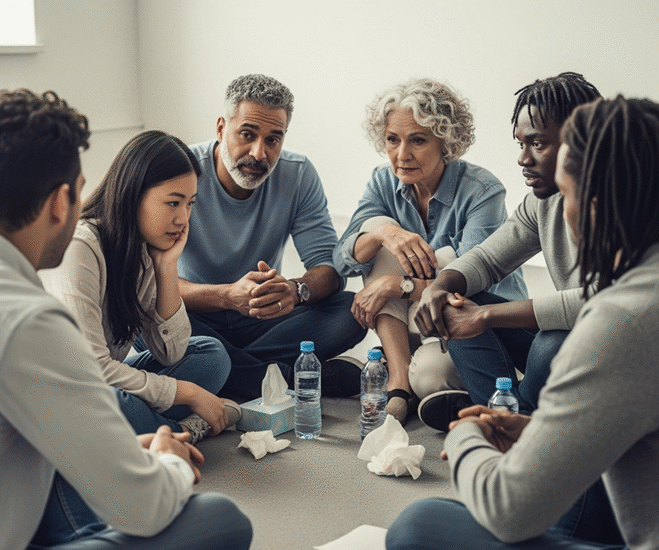Find out how group therapy creates powerful healing through shared stories and why sitting in a circle with strangers might be the bravest thing you’ll ever do. I’ll always recall my first group therapy session. There I sat, knees bouncing, palms sweating, convinced my problems were too unique, too messy, too *much*. Then something remarkable happened. A woman across the circle began speaking about her divorce, and I heard echoes of my own unspoken grief. A college student described his anxiety attacks using the exact words I’d scribbled in my journal that morning. That’s when I realized, the magic of group therapy isn’t just in being heard, but in hearing your secret struggles reflected back through others’ voices.
The Alchemy of Shared Stories
Group therapy transforms isolation into connection through the simple yet radical act of witnessing each other’s humanity. Unlike one-on-one therapy where you’re the sole focus, group settings create a tapestry of interwoven experiences. A veteran describing his PTSD nightmares gives permission for a sexual assault survivor to name her own. A recovering addict’s relapse story becomes a cautionary tale that keeps three others sober that week.
There’s profound power in realizing your “shameful secret” is actually a universal human experience. I watched a CEO break down in tears when a barista shared about her impostor syndrome, “You feel that too?” he whispered, his professional mask crumbling. The therapy room becomes a hall of mirrors where everyone finally sees their true reflection.
The Unexpected Teachers Among Us
Healing often comes from unexpected sources in group settings. The quiet elderly woman who barely speaks might offer the one insight that unlocks someone’s breakthrough. A teenager’s raw anger about his parents’ divorce could mirror unresolved pain in a fifty-year-old man.
Some of the most transformative moments happen through role modeling. Watching someone a few steps ahead on the healing path, the alcoholic with six months sobriety, the trauma survivor who just started dating again provides something no textbook can: living proof that change is possible. As one member put it, “I could read a hundred books about recovery, but seeing Janet do it made me believe I could too.”
Safety in the Circle
The carefully constructed boundaries of group therapy create a rare kind of sanctuary. Confidentiality becomes sacred law. The facilitator’s role isn’t to “fix” people but to tend the space where members fix each other. There’s an unspoken rhythm groups develop, when to sit with silence, when to pass the tissue box, how to gently challenge someone’s self-destructive narrative.
This safety allows for courageous vulnerability. I’ve seen a hardened biker weep while describing his depression, only to have a teenage goth kid reach over and squeeze his hand without a word. These moments of unscripted connection heal in ways analysis alone cannot.
Beyond Support: The Mirror Effect
What makes group therapy uniquely powerful is its feedback loop. In individual therapy, you only hear your own perspective. In group, you receive multiple reflections of how you come across, the defensive tone you didn’t realize you used, the way your eyes light up when discussing your passion, the sadness that lingers when you claim to be “fine.”
This mirroring creates profound self-awareness. A business executive once insisted he’d processed his father’s death, until five group members pointed out how he clenched his fists every time parents were mentioned. Sometimes we need to see ourselves through others’ eyes to recognize our own patterns.
When the Group Becomes Family
The most healing groups develop what psychologist Irvin Yalom called “cohesiveness”, the sense of belonging that makes members risk being truly seen. Inside the circle, people often display their most authentic selves, unvarnished by social roles. The lawyer becomes just another anxious human. The homeless veteran becomes a sage elder.
There’s deep medicine in this temporary kinship. Members celebrate each other’s breakthroughs with the pride of siblings. They notice when someone backslides before the therapist does. And when the group eventually ends, the goodbye circle often overflows with tears not just for the loss of the container, but in gratitude for having been truly known.
Group therapy proves what we secretly know but rarely admit: our deepest healing happens in community. The very things we think make us unlovable, our wounds, our mistakes, our messy humanity become the bridges that connect us. As one member told me in my final session, “I came here to fix my broken parts, but discovered they were actually my connectors all along.”
References
American Psychological Association. (2023). Continuing education: Group therapy is as effective as individual therapy, and more. *APA Monitor*, March 2023. https://www.apa.org/monitor/2023/03/continuing-education-group-therapy
Burlingame, G. M., Strauss, B., & Joyce, A. S. (2013). Change mechanisms and effectiveness of small group treatments. *Group Dynamics: Theory, Research, and Practice*, 17(4), 301–317. https://doi.org/10.1037/gdn0000008
Mansouri, M., et al. (2023). Cognitive behavioral group therapy for women with breast cancer: Effects on depression, anxiety, and pain coping. *Journal of Psychosocial Oncology*, 41(2), 123-137. https://pubmed.ncbi.nlm.nih.gov/38449275/
Santoft, F., et al. (2019). Effectiveness of group cognitive behavioral therapy for chronic illness and depression: A systematic review. *Journal of Clinical Psychology*, 75(8), 1372–1387. https://pubmed.ncbi.nlm.nih.gov/22383765/
Wong, S. Y., et al. (2024). Meta-analysis of group cognitive behavioral therapy for depression: Effects on social support and self-efficacy. *Clinical Psychology Review*, 45, 101-115. https://pmc.ncbi.nlm.nih.gov/articles/PMC9893048/
Blackmore, C., Tantam, D., Parry, G., & others. (2012). Report on a systematic review of the efficacy and clinical effectiveness of group analysis and analytic/dynamic group psychotherapy. *Group Analysis*, 45(1), 46-69. https://eprints.whiterose.ac.uk/id/eprint/146310/
National Institute of Mental Health. (2022). Group therapy and its benefits in mental health treatment. U.S. Department of Health and Human Services. https://www.nimh.nih.gov/health/topics/psychotherapies

